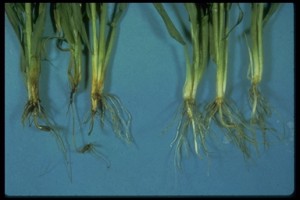With this season's heavy rainfall totals, your over watered plants can suffer from root rot. While root rot is a more common problem with house plants, it can also be very prevalent in landscape plants that are growing in water saturated soils.
The primary cause of root rot on plants is poor drainage and over watering, basically causing the plants roots to sit in water for long periods of time. An occasional event of heavy rains or excess watering is not enough to create a condition of chronically over watered plants that can suffer from root rot. As well, more established landscape plants can tolerate longer periods of over watering more than newly installed plants that have not been able to establish a mature root system.
A healthy root system is vital to the life of your landscape or potted plant. Healthy roots need oxygen to disburse water and nutrients to the plant in order for it to thrive and grow. An over watered plant can suffer from root rot in two basic ways: the available oxygen is pushed out by water, and as the roots sit in water, they will get "wet feet" or rot, similar to us if our feet sat in a tub of water for days and days. As the roots start to die, they are unable to uptake water and nutrients, and the plant will eventually die.
An early symptom of root rot on a plant is yellowing leaves, which indicates that the plant is unable to draw up nutrients through it's roots. An even more definitive symptom of root rot on a plant is leaf wilt, even though the soil is damp or has moisture. This would indicate that the roots are unable to draw up water, because they are compromised and diseased. In some cases, if the plant has value, a soil and root sample can be submitted to a lab for a pathology report, which would identify the particular type of root rot, and allow for potential chemical fungicide treatment.
For most landscape and potted plants, though, a visual examination of the roots is sufficient to identify root rot. A healthy root system is white and present, whereas a root dying from root rot is black, brown, or non-existent, or has necrotic lesions throughout (see image above).
Many times, root rot can be avoided in potted plants by following a few simple steps: Always make sure that your potted plants are potted in a loose, well-draining soil; if you use a saucer to collect water under the pot, never allow water to "stand" in the saucer; water your potted plants only when the soil is dry to the touch about 1" under the surface; use plant "feet" if needed, to keep the bottom of the pot elevated; add rocks or broken pot shards to the bottom of the pot before soil is added to aid in drainage.
With your landscape plants, though, it can be a little more difficult to prevent root rot when Mother Nature is in charge of the watering. You may not be able to avoid over watered plants, but you can use these general rules: Only irrigate plants when the soil is dry 1" under the surface; select plants for typically damp areas that are more tolerant of "wet feet" conditions; install plants flush with the earth or slightly above, and do not mulch heavily against the crown of the plant; add gutters or drainage systems in areas that have chronically saturated soils; recognize the early symptoms of root rot and treat with a root fungicide when possible and feasible.
If you can recognize the symptoms of and the causes of over watered plants that can suffer from root rot, you can take steps to prevent it.

